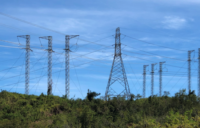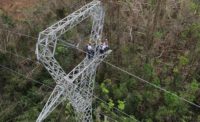Puerto Rico Group Proposes 10-Year, $17.6B Grid Rebuild

Fluor Corp. has more than 1,000 workers on the ground helping to restore power in Puerto Rico under Army Corps contracts that could go as high as $1.3 billion.
Photo Courtesy of Fluor Corp.
Puerto Rico's electric grid would be rebuilt to be more resilient to storms and less reliant on fossil fuels under a 10-year, $17.6-billion plan, announced on Dec. 11 by a working group of Puerto Rico Electric Power Authority (PREPA), New York utilities and Energy Dept. representatives, among others. A council of utility industry leaders named on Dec. 12 will look for ways to implement the plan, according to PREPA.
In the news conference, Puerto Rico Gov. Ricardo Rosselló and New York Gov. Andrew Cuomo called on Congress to approve immediately $94.4 billion for Puerto Rico, including $17.8 billion for the power grid, to help the island recover from Hurricane Maria, which hit on Sept. 20.
"We have an opportunity here, not just to restore power and emerge from bankruptcy but also to establish a model for power generation and delivery in Puerto Rico that sets a global example for cost, resilience, sustainability, and customer engagement and empowerment," said Ernesto Sgroi Hernández, chairman of the PREPA governing board, in a Dec. 12 statement announcing the council of utility leaders.
The "Build Back Better" plan includes short-, mid- and long-term actions, including rebuilding and hardening much of the transmission and distribution system to withstand a Category 4 hurricane (155-mph winds), building 159 microgrids and upgrading the island's generation.
The plan details many of the problems that have slowed power restoration: substations and generation that flooded, transmission and distribution lines and towers that failed, and transmission lines built in remote areas. Seventy-five percent of the island's distribution system was damaged, including flooded underground lines and equipment.
The plan calls to spend $5.3 billion on rebuilding and strengthening the distribution system, including installing more modern controls, undergrounding some lines and inserting breakaway connectors. During Hurricane Maria, the lack of breakaway connectors led to a domino effect, causing long sections of lines to fail successively.
Another $4.9 billion would be spent to upgrade the transmission system. The plan recommends installing monopole towers on stronger foundations, rather than the standard lattice towers that Maria's winds crumpled like tin cans. The plan also recommends a new transmission grid to be built alongside major roads. The existing lines, many 50 years old, were built through forests and mountains. The plan calls for spending $600 million to bury transmission lines most vulnerable to wind. Separately, $1.7 billion would be spent on the island's electric substations, hardening them with sandbags and floodwalls and raising some. More than 90% of the island's 334 substations need upgrades. After the storm, 131 of them suffered major damage from Hurricane Maria, while only 12 remained in good condition.
Repairing existing power plants, including making upgrades that were called for before the storm, including conversion to natural gas from oil, will cost $3.1 billion, according to the plan.
About $1.5 billion would be needed for distributed energy resources, such as microgrids, to be built at the island's hospitals, emergency shelters, wastewater and water-treatment facilities, police and fire stations, and rural communities. The microgrids would power the small areas and facilities with a combination of diesel, solar power and batteries. The plan also calls for installing more solar power on the roofs of rebuilt homes.
"While the storms created several significant challenges, they also now offer an opportunity for overall improvement and stability of the generating fleet, as well as the expedited implementation of the recommendations in the recent [integrated resource plan]," according to the rebuild plan. "The timing of when the repairs and/or replacement will take place requires strong coordination that allows for the use of existing generating units for the short-term production of needed electricity, as well as the longer-term shift from oil- to gas-fired generation, installation of [distributed energy-resource] capabilities, and shutdown of existing, older generation units. Further, the introduction of large and distributed renewable resources, including energy storage and microgrids, may lessen PREPA's dependence on large central generating stations, with the potential to retire existing plants and/or defer new ones."
Restoration Continues
PREPA, the Army Corps of Engineers and contractors, including Fluor, still are focused on restoring power to the island. As of Dec. 11, about 64% of the island's power, 82% percent of substations and 71% of transmission centers are working, according to the Corps. The Corps and Louis Berger recently installed a microgrid with two large generators on Culebra, a Puerto Rico island of about 1,800 people. The microgrid can supply power to the island 24 hours a day. Culebra used to receive power through a subsea cable from the Puerto Rico island of Vieques, but the connections at both ends of the cable were damaged by the storm.
The Corps said about 3,000 workers, including contractors, are working to restore power to Puerto Rico, and more are coming. Fluor recently won a Corps contract for up to $831 million in power-restoration work, bringing its potential work on the island up to $1.3 billion. The company has more than 1,000 workers on the island. Whitefish Energy, whose $300-million contract to restore power was canceled by PREPA over controversy about the company's experience and rates, finished its work on Dec. 6, and lineman and equipment brought by the company have returned to the mainland. But Whitefish said several subcontractors have stayed behind to work for other companies.



